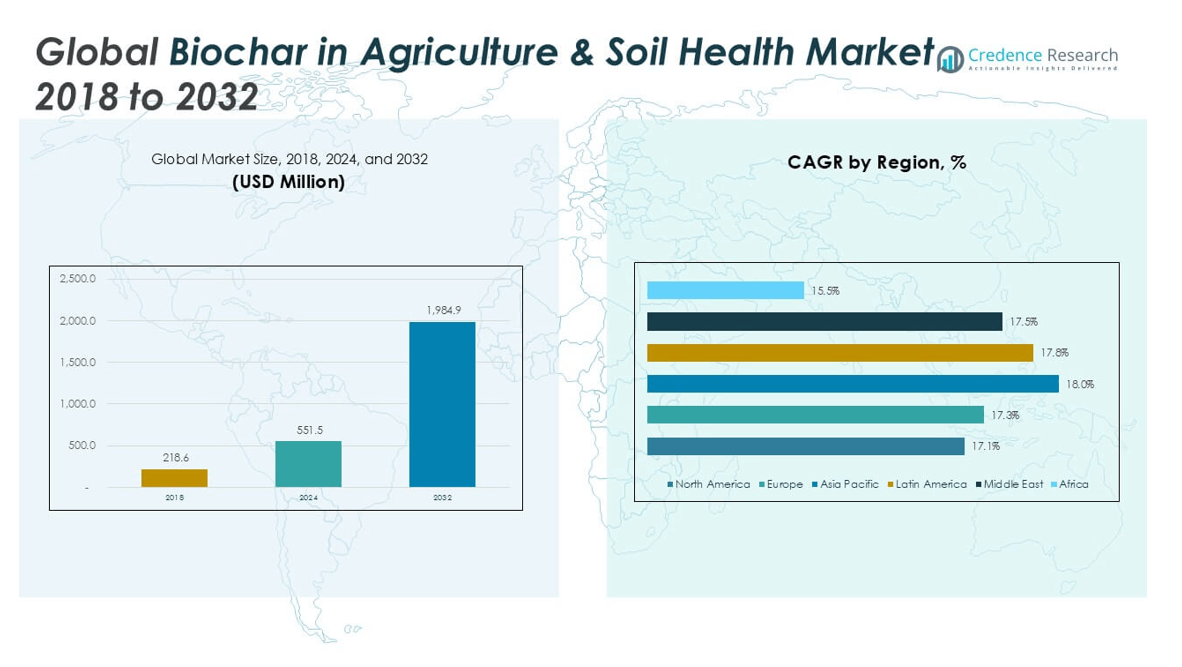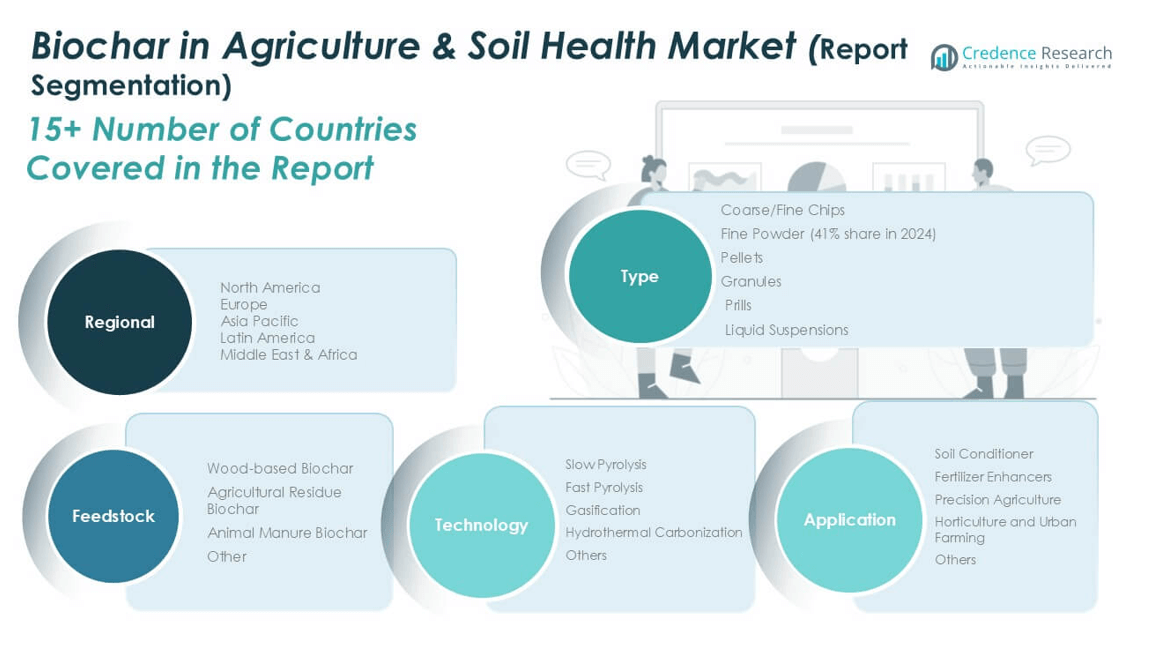CHAPTER NO. 1: GENESIS OF THE MARKET
1.1 Market Prelude – Introduction & Scope
1.2 The Big Picture – Objectives & Vision
1.3 Strategic Edge – Unique Value Proposition
1.4 Stakeholder Compass – Key Beneficiaries
CHAPTER NO. 2: EXECUTIVE LENS
2.1 Pulse of the Industry – Market Snapshot
2.2 Growth Arc – Revenue Projections (USD Million)
2.3. Premium Insights – Based on Primary Interviews
CHAPTER NO. 3: BIOCHAR IN AGRICULTURE & SOIL HEALTH MARKET FORCES & INDUSTRY PULSE
3.1 Foundations of Change – Market Overview
3.2 Catalysts of Expansion – Key Market Drivers
3.2.1 Momentum Boosters – Growth Triggers
3.2.2 Innovation Fuel – Disruptive Technologies
3.3 Headwinds & Crosswinds – Market Restraints
3.3.1 Regulatory Tides – Compliance Challenges
3.3.2 Economic Frictions – Inflationary Pressures
3.4 Untapped Horizons – Growth Potential & Opportunities
3.5 Strategic Navigation – Industry Frameworks
3.5.1 Market Equilibrium – Porter’s Five Forces
3.5.2 Ecosystem Dynamics – Value Chain Analysis
3.5.3 Macro Forces – PESTEL Breakdown
3.6 Price Trend Analysis
3.6.1 Regional Price Trend
3.6.2 Price Trend By Type
CHAPTER NO. 4: KEY INVESTMENT EPICENTER
4.1 Regional Goldmines – High-Growth Geographies
4.2 Product Frontiers – Lucrative Type Categories
4.3 Technology Sweet Spots – Emerging Demand Segments
CHAPTER NO. 5: REVENUE TRAJECTORY & WEALTH MAPPING
5.1 Momentum Metrics – Forecast & Growth Curves
5.2 Regional Revenue Footprint – Market Share Insights
5.3 Segmental Wealth Flow – Type, Feedstock, Technology, & Application Industry Revenue
CHAPTER NO. 6: TRADE & COMMERCE ANALYSIS
6.1. Import Analysis By Region
6.1.1. Global Biochar in Agriculture & Soil Health Market Import Revenue By Region
6.2. Export Analysis By Region
6.2.1. Global Biochar in Agriculture & Soil Health Market Export Revenue By Region
CHAPTER NO. 7: COMPETITION ANALYSIS
7.1. Company Market Share Analysis
7.1.1. Global Biochar in Agriculture & Soil Health Market: Company Market Share
7.2. Global Biochar in Agriculture & Soil Health Market Company Revenue Market Share
7.3. Strategic Developments
7.3.1. Acquisitions & Mergers
7.3.2. New Type Launch
7.3.3. Regional Expansion
7.4. Competitive Dashboard
7.5. Company Assessment Metrics, 2024
CHAPTER NO. 8: BIOCHAR IN AGRICULTURE & SOIL HEALTH MARKET – BY TYPE SEGMENT ANALYSIS
8.1. Biochar in Agriculture & Soil Health Market Overview By Type Segment
8.1.1. Biochar in Agriculture & Soil Health Market Revenue Share By Type
8.2. Coarse/Fine Chips
8.3. Fine Powder (41% share in 2024)
8.4. Pellets
8.5. Granules
8.6. Prills
CHAPTER NO. 9 : BIOCHAR IN AGRICULTURE & SOIL HEALTH MARKET – BY FEEDSTOCK SEGMENT ANALYSIS
9.1. Biochar in Agriculture & Soil Health Market Overview By Feedstock Segment
9.1.1. Biochar in Agriculture & Soil Health Market Revenue Share By Feedstock
9.2. Wood-based Biochar
9.3. Agricultural Residue Biochar
9.4. Animal Manure Biochar
9.5. Other
CHAPTER NO. 10: BIOCHAR IN AGRICULTURE & SOIL HEALTH MARKET – BY TECHNOLOGY SEGMENT ANALYSIS
10.1. Biochar in Agriculture & Soil Health Market Overview By Technology Segment
10.1.1. Biochar in Agriculture & Soil Health Market Revenue Share By Technology
10.2. Slow Pyrolysis
10.3. Fast Pyrolysis
10.4. Gasification
10.5. Hydrothermal Carbonization
10.6. Others
CHAPTER NO. 11: BIOCHAR IN AGRICULTURE & SOIL HEALTH MARKET – BY APPLICATION INDUSTRY SEGMENT ANALYSIS
11.1. Biochar in Agriculture & Soil Health Market Overview By Application Industry Segment
11.1.1. Biochar in Agriculture & Soil Health Market Revenue Share By Application Industry
11.2. Soil Conditioner
11.3. Fertilizer Enhancers
11.4. Precision Agriculture
11.5. Horticulture and Urban Farming
11.6. Others
CHAPTER NO. 12: BIOCHAR IN AGRICULTURE & SOIL HEALTH MARKET – REGIONAL ANALYSIS
12.1. Biochar in Agriculture & Soil Health Market Overview By Region Segment
12.1.1. Global Biochar in Agriculture & Soil Health Market Revenue Share By Region
12.1.2. Regions
12.1.3. Global Biochar in Agriculture & Soil Health Market Revenue By Region
12.1.4. Type
12.1.5. Global Biochar in Agriculture & Soil Health Market Revenue By Type
12.1.6. Feedstock
12.1.7. Global Biochar in Agriculture & Soil Health Market Revenue By Feedstock
12.1.8. Technology
12.1.9. Global Biochar in Agriculture & Soil Health Market Revenue By Technology
12.1.10. Application Industry
12.1.11. Global Biochar in Agriculture & Soil Health Market Revenue By Application Industry
CHAPTER NO. 13: NORTH AMERICA BIOCHAR IN AGRICULTURE & SOIL HEALTH MARKET – COUNTRY ANALYSIS
13.1. North America Biochar in Agriculture & Soil Health Market Overview By Country Segment
13.1.1. North America Biochar in Agriculture & Soil Health Market Revenue Share By Region
13.2. North America
13.2.1. North America Biochar in Agriculture & Soil Health Market Revenue By Country
13.2.2. Type
13.2.3. North America Biochar in Agriculture & Soil Health Market Revenue By Type
13.2.4. Feedstock
13.2.5. North America Biochar in Agriculture & Soil Health Market Revenue By Feedstock
13.2.6. Technology
13.2.7. North America Biochar in Agriculture & Soil Health Market Revenue By Technology
13.2.8. Application Industry
13.2.9. North America Biochar in Agriculture & Soil Health Market Revenue By Application Industry
13.3. U.S.
13.4. Canada
13.5. Mexico
CHAPTER NO. 14: EUROPE BIOCHAR IN AGRICULTURE & SOIL HEALTH MARKET – COUNTRY ANALYSIS
14.1. Europe Biochar in Agriculture & Soil Health Market Overview By Country Segment
14.1.1. Europe Biochar in Agriculture & Soil Health Market Revenue Share By Region
14.2. Europe
14.2.1. Europe Biochar in Agriculture & Soil Health Market Revenue By Country
14.2.2. Type
14.2.3. Europe Biochar in Agriculture & Soil Health Market Revenue By Type
14.2.4. Feedstock
14.2.5. Europe Biochar in Agriculture & Soil Health Market Revenue By Feedstock
14.2.6. Technology
14.2.7. Europe Biochar in Agriculture & Soil Health Market Revenue By Technology
14.2.8. Application Industry
14.2.9. Europe Biochar in Agriculture & Soil Health Market Revenue By Application Industry
14.3. UK
14.4. France
14.5. Germany
14.6. Italy
14.7. Spain
14.8. Russia
14.9. Rest of Europe
CHAPTER NO. 15: ASIA PACIFIC BIOCHAR IN AGRICULTURE & SOIL HEALTH MARKET – COUNTRY ANALYSIS
15.1. Asia Pacific Biochar in Agriculture & Soil Health Market Overview By Country Segment
15.1.1. Asia Pacific Biochar in Agriculture & Soil Health Market Revenue Share By Region
15.2. Asia Pacific
15.2.1. Asia Pacific Biochar in Agriculture & Soil Health Market Revenue By Country
15.2.2. Type
15.2.3. Asia Pacific Biochar in Agriculture & Soil Health Market Revenue By Type
15.2.4. Feedstock
15.2.5. Asia Pacific Biochar in Agriculture & Soil Health Market Revenue By Feedstock
15.2.6. Technology
15.2.7. Asia Pacific Biochar in Agriculture & Soil Health Market Revenue By Technology
15.2.8. Application Industry
15.2.9. Asia Pacific Biochar in Agriculture & Soil Health Market Revenue By Application Industry
15.3. China
15.4. Japan
15.5. South Korea
15.6. India
15.7. Australia
15.8. Southeast Asia
15.9. Rest of Asia Pacific
CHAPTER NO. 16: LATIN AMERICA BIOCHAR IN AGRICULTURE & SOIL HEALTH MARKET – COUNTRY ANALYSIS
16.1. Latin America Biochar in Agriculture & Soil Health Market Overview By Country Segment
16.1.1. Latin America Biochar in Agriculture & Soil Health Market Revenue Share By Region
16.2. Latin America
16.2.1. Latin America Biochar in Agriculture & Soil Health Market Revenue By Country
16.2.2. Type
16.2.3. Latin America Biochar in Agriculture & Soil Health Market Revenue By Type
16.2.4. Feedstock
16.2.5. Latin America Biochar in Agriculture & Soil Health Market Revenue By Feedstock
16.2.6. Technology
16.2.7. Latin America Biochar in Agriculture & Soil Health Market Revenue By Technology
16.2.8. Application Industry
16.2.9. Latin America Biochar in Agriculture & Soil Health Market Revenue By Application Industry
16.3. Brazil
16.4. Argentina
16.5. Rest of Latin America
CHAPTER NO. 17: MIDDLE EAST BIOCHAR IN AGRICULTURE & SOIL HEALTH MARKET – COUNTRY ANALYSIS
17.1. Middle East Biochar in Agriculture & Soil Health Market Overview By Country Segment
17.1.1. Middle East Biochar in Agriculture & Soil Health Market Revenue Share By Region
17.2. Middle East
17.2.1. Middle East Biochar in Agriculture & Soil Health Market Revenue By Country
17.2.2. Type
17.2.3. Middle East Biochar in Agriculture & Soil Health Market Revenue By Type
17.2.4. Feedstock
17.2.5. Middle East Biochar in Agriculture & Soil Health Market Revenue By Feedstock
17.2.6. Technology
17.2.7. Middle East Biochar in Agriculture & Soil Health Market Revenue By Technology
17.2.8. Application Industry
17.2.9. Middle East Biochar in Agriculture & Soil Health Market Revenue By Application Industry
17.3. GCC Countries
17.4. Israel
17.5. Turkey
17.6. Rest of Middle East
CHAPTER NO. 18: AFRICA BIOCHAR IN AGRICULTURE & SOIL HEALTH MARKET – COUNTRY ANALYSIS
18.1. Africa Biochar in Agriculture & Soil Health Market Overview By Country Segment
18.1.1. Africa Biochar in Agriculture & Soil Health Market Revenue Share By Region
18.2. Africa
18.2.1. Africa Biochar in Agriculture & Soil Health Market Revenue By Country
18.2.2. Type
18.2.3. Africa Biochar in Agriculture & Soil Health Market Revenue By Type
18.2.4. Feedstock
18.2.5. Africa Biochar in Agriculture & Soil Health Market Revenue By Feedstock
18.2.6. Technology
18.2.7. Africa Biochar in Agriculture & Soil Health Market Revenue By Technology
18.2.8. Application Industry
18.2.9. Africa Biochar in Agriculture & Soil Health Market Revenue By Application Industry
18.3. South Africa
18.4. Egypt
18.5. Rest of Africa
CHAPTER NO. 19: COMPANY PROFILES
19.1. Cool Planet Energy Systems Inc.
19.1.1. Company Overview
19.1.2. Product Portfolio
19.1.3. Financial Overview
19.1.4. Recent Developments
19.1.5. Growth Strategy
19.1.6. SWOT Analysis
19.2. Biochar Supreme
19.3. Pacific Biochar Benefit Corporation
19.4. Biochar Now, LLC
19.5. The Biochar Company (TBC) / Soil Reef
19.6. CharGrow LLC
19.7. Carbon Gold Ltd.
19.8. Airex Energy
19.9. Aries Clean Energy
19.10. Swiss Biochar GmbH
19.11. Arsta Eco / ECOSUS
19.12. Cookswell Jikos
19.13. Oregon Biochar Solutions
19.14. Hubei Jinri Ecology-Energy
19.15. Liaoning Jinhefu Group









